Voluntary running exercise protects against sepsis-induced early inflammatory and pro-coagulant responses in aged mice
- PMID: 28789683
- PMCID: PMC5549433
- DOI: 10.1186/s13054-017-1783-1
Voluntary running exercise protects against sepsis-induced early inflammatory and pro-coagulant responses in aged mice
Abstract
Background: Despite many animal studies and clinical trials, mortality in sepsis remains high. This may be due to the fact that most experimental studies of sepsis employ young animals, whereas the majority of septic patients are elderly (60 - 70 years). The objective of the present study was to examine the sepsis-induced inflammatory and pro-coagulant responses in aged mice. Since running exercise protects against a variety of diseases, we also examined the effect of voluntary running on septic responses in aged mice.
Methods: Male C57BL/6 mice were housed in our institute from 2-3 to 22 months (an age mimicking that of the elderly). Mice were prevented from becoming obese by food restriction (given 70-90% of ad libitum consumption amount). Between 20 and 22 months, a subgroup of mice ran voluntarily on wheels, alternating 1-3 days of running with 1-2 days of rest. At 22 months, mice were intraperitoneally injected with sterile saline (control) or 3.75 g/kg fecal slurry (septic). At 7 h post injection, we examined (1) neutrophil influx in the lung and liver by measuring myeloperoxidase and/or neutrophil elastase in the tissue homogenates by spectrophotometry, (2) interleukin 6 (IL6) and KC in the lung lavage by ELISA, (3) pulmonary surfactant function by measuring percentage of large aggregates, (4) capillary plugging (pro-coagulant response) in skeletal muscle by intravital microscopy, (5) endothelial nitric oxide synthase (eNOS) protein in skeletal muscle (eNOS-derived NO is putative inhibitor of capillary plugging) by immunoblotting, and (6) systemic blood platelet counts by hemocytometry.
Results: Sepsis caused high levels of pulmonary myeloperoxidase, elastase, IL6, KC, liver myeloperoxidase, and capillary plugging. Sepsis also caused low levels of surfactant function and platelet counts. Running exercise increased eNOS protein and attenuated the septic responses.
Conclusions: Voluntary running protects against exacerbated sepsis-induced inflammatory and pro-coagulant responses in aged mice. Protection against pro-coagulant responses may involve eNOS upregulation. The present discovery in aged mice calls for clinical investigation into potential beneficial effects of exercise on septic outcomes in the elderly.
Keywords: Aging; Capillary plugging; Pulmonary inflammation; Voluntary running; sepsis.
Conflict of interest statement
Ethics approval
Experimental protocols were performed in accordance with the Canadian Council on Animal Care guidelines for the care and handling of animals. The institutional Animal Care Committee approved our studies (Approval # 2011-062).
Consent for publication
Not applicable.
Competing interests
The authors declare that they have no competing interests.
Publisher’s Note
Springer Nature remains neutral with regard to jurisdictional claims in published maps and institutional affiliations.
Figures
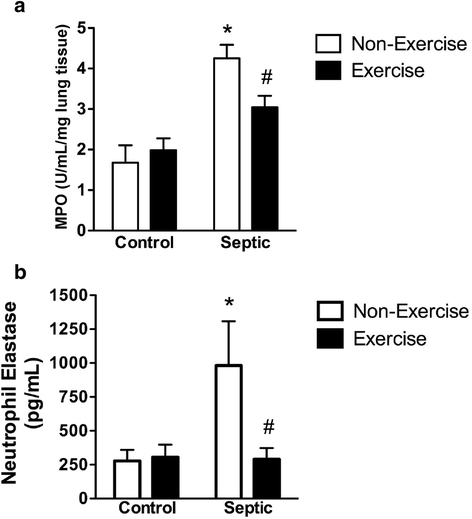
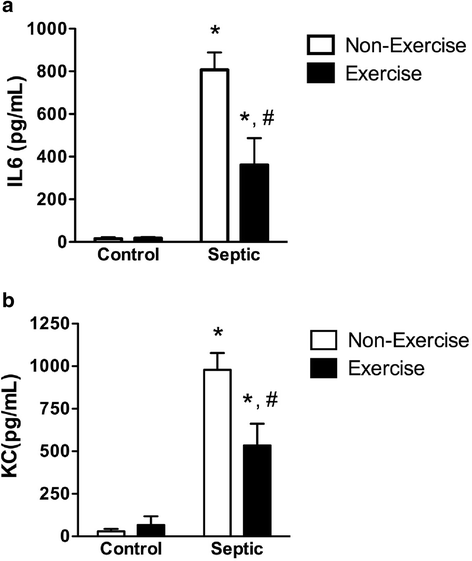
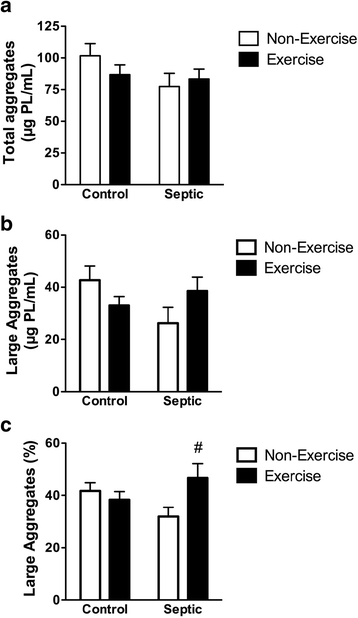
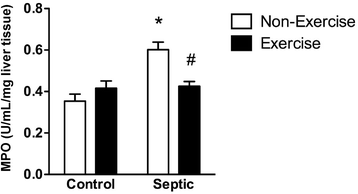
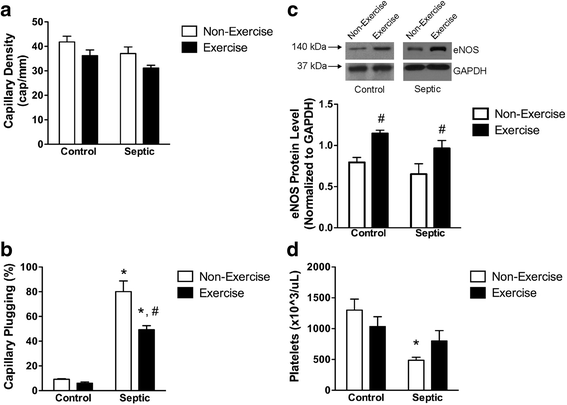
Similar articles
-
Erythropoietin improves skeletal muscle microcirculation through the activation of eNOS in a mouse sepsis model.J Trauma. 2011 Nov;71(5 Suppl 1):S462-7. doi: 10.1097/TA.0b013e318232e7a2. J Trauma. 2011. PMID: 22072004
-
Short-term effect of ascorbate on bacterial content, plasminogen activator inhibitor-1, and myeloperoxidase in septic mice.J Surg Res. 2014 Oct;191(2):432-40. doi: 10.1016/j.jss.2014.04.017. Epub 2014 Apr 13. J Surg Res. 2014. PMID: 24814200
-
Advanced age exacerbates the pulmonary inflammatory response after lipopolysaccharide exposure.Crit Care Med. 2007 Jan;35(1):246-51. doi: 10.1097/01.CCM.0000251639.05135.E0. Crit Care Med. 2007. PMID: 17133178
-
Critical role for oxidative stress, platelets, and coagulation in capillary blood flow impairment in sepsis.Microcirculation. 2011 Feb;18(2):152-62. doi: 10.1111/j.1549-8719.2010.00080.x. Microcirculation. 2011. PMID: 21199094 Review.
-
Vitamin C and Microvascular Dysfunction in Systemic Inflammation.Antioxidants (Basel). 2017 Jun 29;6(3):49. doi: 10.3390/antiox6030049. Antioxidants (Basel). 2017. PMID: 28661424 Free PMC article. Review.
Cited by
-
Mechanisms of exercise-induced preconditioning in skeletal muscles.Redox Biol. 2020 Aug;35:101462. doi: 10.1016/j.redox.2020.101462. Epub 2020 Feb 20. Redox Biol. 2020. PMID: 32089451 Free PMC article. Review.
-
Protective effect of exercise on animals with sepsis: a systematic review of the existing literature.BMC Infect Dis. 2025 Feb 8;25(1):195. doi: 10.1186/s12879-025-10557-7. BMC Infect Dis. 2025. PMID: 39923007 Free PMC article.
-
Identifying the genetic association between rheumatoid arthritis and the risk of infectious diseases.Clin Rheumatol. 2025 Jul;44(7):2611-2619. doi: 10.1007/s10067-025-07485-x. Epub 2025 May 16. Clin Rheumatol. 2025. PMID: 40377766
-
Aerobic Exercise Protects against Cardiotoxin-Induced Skeletal Muscle Injury in a DDAH1-Dependent Manner.Antioxidants (Basel). 2024 Sep 1;13(9):1069. doi: 10.3390/antiox13091069. Antioxidants (Basel). 2024. PMID: 39334728 Free PMC article.
-
Demonstration of ameliorating effect of papaverine in sepsis-induced acute lung injury on rat model through radiology and histology.Ulus Travma Acil Cerrahi Derg. 2023 Sep;29(9):963-971. doi: 10.14744/tjtes.2023.73580. Ulus Travma Acil Cerrahi Derg. 2023. PMID: 37681716 Free PMC article.
References
-
- Martin CM, Priestap F, Fisher H, Fowler RA, Heyland DK, Keenan SP, Longo CJ, Morrison T, Bentley D, Antman N, STAR Registry Investigators A prospective, observational registry of patients with severe sepsis: the Canadian Sepsis Treatment and Response Registry. Crit Care Med. 2009;37:81–8. doi: 10.1097/CCM.0b013e31819285f0. - DOI - PubMed
-
- Martin GS, Mannino DM, Moss M. The effect of age on the development and outcome of adult sepsis. Crit Care Med. 2006;34:15–21. doi: 10.1097/01.CCM.0000194535.82812.BA. - DOI - PubMed
Publication types
MeSH terms
Substances
Grants and funding
LinkOut - more resources
Full Text Sources
Other Literature Sources
Medical
Research Materials
Miscellaneous

